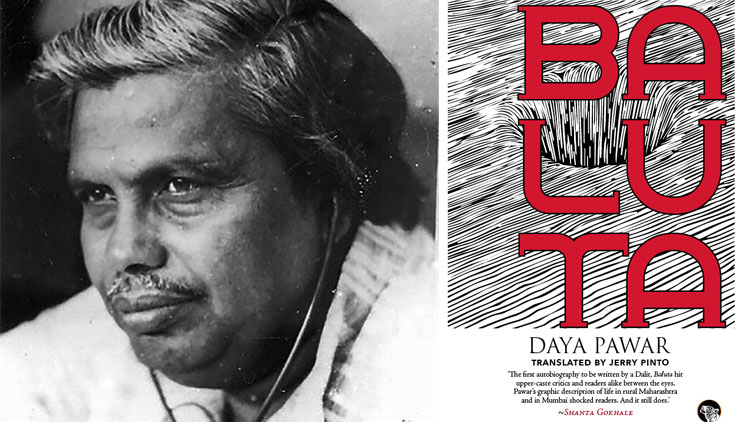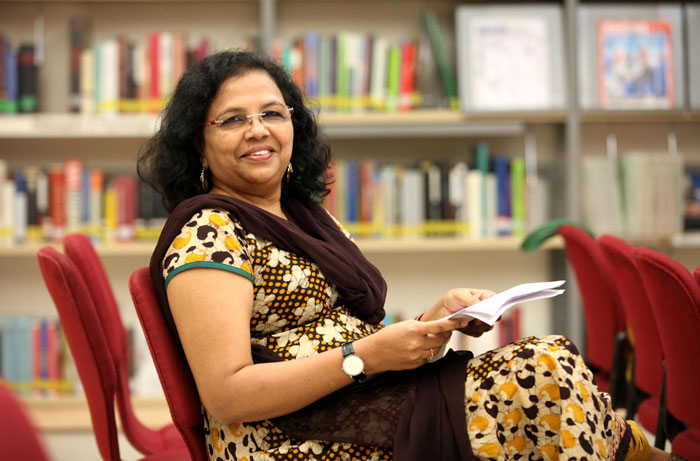- India
- International
How Daya Pawar’s autobiography became the template for the angry Dalit memoir
Daya Pawar aka Dagdu Maruti Pawar was a genial, friendly person. Looking back at the life and legacy of Daya Pawar, as an English translation of Baluta is published.
 Daya Pawar
Daya Pawar
Every weekend, eight-year-old Pradnya Pawar loved nothing more than to listen in on the conversations between her father and his friends in their house along the Oshiwara creek in suburban Bombay. When the adults went out, she would skim through their notes and read the poetry they had written, not understanding a word. Yet she knew in her bones that something significant was stirring right there.
The year was 1972. For her father, Dagdu Maruti Pawar, these animated discussions on politics and poetry and the company of fellow Dalit writers like Namdeo Dhasal, Arjun Dangle and Narayan Surve, was his way of keeping the revolutionary in him alive. His job as a clerk with the railways department didn’t allow him to adopt an overt political role. The conversations fuelled his literary pursuits and his works, written under the pen name Daya Pawar, showed the way for a generation of Marathi Dalit writers.
Baluta, one of the first Dalit autobiographies, was conceived in these exchanges. While Anna Bahu Sathe and Baburao Bagul had written about their lives before, Pawar’s work had a searing directness, which was to become a hallmark of the Dalit memoir.
With his friends, Pawar would talk about the life of deprivation that the caste system forced on members of his Mahar community. Made to live on the edge of a village in what was known as Maharwada, they were untouchables, treated as bonded labour by upper caste villagers and assigned tasks such as the skinning of dead cattle. In return for their labour, the Mahars received baluta — their share in the village produce and their only means of survival.
 Daya Pawar’s daughter Pradnya, a feminist Dalit writer
Daya Pawar’s daughter Pradnya, a feminist Dalit writer
“To our upper-caste writer friends, such discrimination was unheard of,” says writer Arjun Dangle, who edited Poisoned Bread (1992), an anthology of Dalit writing. “They encouraged Daya to write his memoirs, which were then published in 1978,” says Dangle, who read the early drafts of Baluta.

With its raw yet simple narrative, Baluta shook the world of Marathi literature, turning the Dalit memoir into a weapon flung at the caste system. Soon after, a number of Dalit autobiographies were published — Laxman Mane’s Sahitya Akademi Award-winning Upara and Laxman Gaikwad’s Uchalya, among others. The English translation of Pawar’s seminal work comes 37 years later. Published by Speaking Tiger, writer Jerry Pinto has translated the text.
Pawar was born in 1935 in Dhamangaon, a village in Ahmednagar district of Maharashtra. He spent the early years of his life in Kawakhana, on the edge of Bombay’s red-light district Kamathipura. He lived with his extended family in a 10ft-by-12ft room, where wooden boxes acted as partition and rags hanging from ropes as temporary walls. His father worked in the docks and his mother as a scavenger. Life wasn’t easy in the city. But when his father lost his job, Pawar found himself on the fringe of the village again, separated from the rest by the impermeable wall of caste.
In Baluta, Pawar writes of these experiences — having to sit at an angle from the upper-caste students in school, knocking on the doors of upper-caste villagers for leftovers, being ridiculed for his name which meant “stone”. He began to question the caste system early on. Books not only became a means of escape but also strengthened his resolve to educate himself and return to a respectable life in the city. But despite his education, the deep-seated caste system dictated his job prospects. His first job was in the lab of a veterinary hospital, as an assistant in charge of changing the fluids of animals’ stool samples.
Pawar began his journey as a writer of romantic poetry in the 1960s. “At the time, Dalit writers had no space in mainstream publications. Our contributions would be returned with a letter of thanks,” says Dalit writer JV Pawar, who later co-founded the Dalit Panthers party.
By late 1960s, the Little Magazine movement, driven by self-published cyclostyled magazines, was transforming Marathi literature. Several new talents emerged, including Bhalchandra Nemade, Vilas Sarang, Dilip Chitre and Arun Kolatkar. One of its biggest contribution was the thrust it gave to Dalit literature, which became difficult to ignore. “The poetry of Bagul, Pawar, Namdeo Dhasal was rooted in their pain and anger. It was brazen yet close to life,” says Ramdas Bhatkal of Popular Prakashan, a publishing house in Bombay. Dalit writers taught Marathi readers to see Hindu mythology anew; Eklavya was reinterpreted as a subaltern hero and Soorpanakha’s assertion of her sexuality made her a feminist icon.
By the early 1970s, Pawar had established himself in the literary circles with his collection of poems, Kondwada. Published in 1969, the poetry spoke of the social and cultural constrictions of caste and gender. “He had a beautiful, Pahari voice. He would travel to villages, recite his poetry and songs he wrote based on folk tunes, asking his people to question the caste system and join the Dalit movement,” says Dangle.
His revolutionary writing, however, didn’t reflect in his personal life. Even though the Dalit Panthers was taking shape in his frontyard, he maintained his distance. Remembered by everyone as a soft-spoken, genial intellectual, he was not in agreement with the violent ways of the Panthers. Pawar’s wife, Hira Daya Pawar, points out that he would have had a more political role if he did not have a family to fend for. “He wanted to quit his government job and join the movement but I had made it clear that I was unwilling to live a life of poverty,” she says.
His politics was evident in his writing and the unfailing support he lent to his young and revolutionary friends. “If Dalit Panthers brought out a morcha, he wouldn’t join it but walk on the footpath alongside,” says Hira, laughing. The Pawar residence was not only the meeting point for Dalit poets and Panther volunteers but also their refuge.
Pawar had friends in various arts and cultural circles, including savarna (upper caste) writers such as Arun Sadhu and Dinkar Gangal. Marathi humourist PL Deshpande was a friend and admirer and the first to write about Baluta. Pawar would often act as a bridge between people of conflicting ideologies. “Everywhere I go in Maharashtra, I am told by people that they knew dada, that he ate at their home. I sometimes ask my mother if he ever refused a dinner invitation,” says Pradnya, 48, the eldest of Hira and Pawar’s three children.
It was in this politically-charged environment that Pradnya spent her formative years. “With an arrest warrant on his name, Namdeo kaka would practically live out of our home. He would paint boards for the Keshav Gore Trust during the day and hide in the loft or the bathroom in case of a police raid. Some evenings, he would take me for a ride on his bike and on others, I would listen to his poetry,” she says.
It would be impossible to separate the Dalit political movement from the literary avant garde of Marathi literature in the 1970s and 1980s. If the political movement demanded the annihilation of caste, Dalit writing was smashing the rules of style, language and decorum. “Likhna, jeena aur sangharsh karna, yeh sab ek doosre ke pehlu the. Yeh jo jee rahe the, apne haq ke liye lad rahe hain, kabhi raste par utar aate the, kabhi pen utha lete the (Writing, living and agitating weren’t separate activities for them. To fight for their rights, they would sometimes take to the streets and at other times, pick up the pen),” says Pradnya.
Like many men of the time, Pawar’s attitude to women was complicated. He had seen the hardships his mother faced. That led Pawar to become a great propagator of women’s rights, and he would encourage Pradnya’s feminist voice. Yet, in Baluta, he doesn’t project himself as the victim. Instead, he implicates himself, admitting to abandoning his first wife and daughter because he suspected her of cheating on him.
Hira accepts that Pawar was not like the men he grew up with — who beat their wives, lived off their earnings and cheated on them. Yet, he had his flaws. “For a long time, he didn’t allow me to work. He would say I should instead care for our three children. While he had a point, I sometimes wonder if it was his insecurity as I was more educated than him,” says Hira who released her autobiography Sangayachi Gosht Manjhe… (Truth Be Told…) in 2012.
While Baluta remained seminal, it also fetched the author immense criticism from Dalits angered by his depiction of the Mahar practice of polygamy. “We would receive hate letters and were ostracised by our community. The emerging Dalit middle-class that had distanced itself from its past felt that Daya had opened their wounds again and caused them shame,” says Hira.
Pradnya too believes Baluta proved to be a double-edged sword. “It brought him fame and awards. But it also caused him immense pain and distress. It’s only in retrospect that Baluta is considered iconic by the Dalit community,” she says.
The story appeared in print with the headline Speak, Bitter Memory
Apr 25: Latest News
- 01
- 02
- 03
- 04
- 05




































